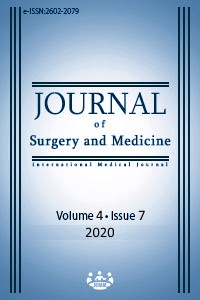Treatment of fistula-in-ano: Outcome comparison between traditional surgery and novel approaches. A retrospective cohort study in a single center
Keywords:
Anal fistula, Fistulotomy, Fistulectomy, Seton, VAAFT, Lipogems®, Micro-fragmented adipose tissueAbstract
Aim: Fistula-in-ano is a well described disease but no definitive surgical technique has been developed. We conducted a retrospective cohort study in a single center to evaluate patients who underwent surgical treatment of a perianal fistula from 2012 to 2018 in our hospital. The aim of the study was to compare the outcome of different surgical techniques (Fistulotomy/fistulectomy and seton, Video-Assisted Anal Fistula Treatment (VAAFT), Micro-fragmented adipose tissue injection, Lipogems®).
Methods: A cohort of 103 patients with anal fistula who qualified for elective surgery between 2012 and 2018 were recruited at Sant’Anna Hospital in Ferrara. All patients underwent a digital rectal examination and preoperative magnetic resonance imaging (MRI) to identify the fistula tract and internal opening. Patients were divided into 4 groups, one for each type of surgery they underwent: Fistulotomy/fistulectomy and seton, Video-Assisted Anal Fistula Treatment (VAAFT), Micro-fragmented adipose tissue injection, Lipogems®). Numerical rating scale (NRS) was used to assess subjective pain one week after surgery and documented. The scale ranged from 0 to 10, where 0 stands for no pain and 10 stands for worst pain ever faced. Primary end point was fistula recurrence at 1 year of follow-up. Secondary end point was evaluation of post-operative pain.
Results: There were 71 males and 32 females, with a median age of 50 years (range 21-89 years). Among them, 79 patients were newly diagnosed, the other 24 patients had undergone previous surgery and had recurrence. In total, 118 surgical operation were performed for anal fistula. During the follow-up period, anal fistula recurrence was observed in 13 patients after VAAFT, 3 patients after Micro-fragmented adipose tissue injection, 4 after fistulotomy, 12 after fistulectomy, 10 after seton placement and 8 after Lipogems® technique. One week after surgery, pain was evaluated by all patients on a scale from 0 to 10. The mean scores of patients who underwent VAAFT, micro-fragmented adipose tissue injection, fistulotomy, fistulectomy, seton placement and Lipogems® technique were 1 (0-5), 1.5 (0-8), 5 (3-8), 6.8 (5-9), 4.2 (2-6) and 0 (0-2), respectively.
Conclusion: This study presents the difficulties in managing anal fistulas and the variety of surgical options. VAAFT and Micro-fragmented adipose tissue injection appear to be safe and feasible options in the management of anal fistula, and short-term healing rates are acceptable with no sustained effect on continence. There is, however, a paucity of robust data with long-term outcomes. These techniques are thus welcome additions. Lipogems ® technique is a safe and reproducible procedure, unfortunately according to our experience, it does not promote fistula healing in patients with recurrent inter-sphincteric anal fistula. We do not suggest the use of this technique as a first-line treatment.
Downloads
References
Sherief S, Steven DW. Idiopathic fistula-in-ano. World J Gastroenterol. 2011;17(28):3277-85.
Sandborn WJ, Fazio VW, Feagan BG, Hanauer SB. AGA technical review on perianal Crohn’s disease. Gastroenterology. 2003;125(5):1508–30.
Amato A, Bottini C, De Nardi P, Giamundo P, Lauretta A, Realis LA, et al Evaluation and managementof perianal abscess and anal fistula: a consensus statement developed by the Italian Society of Colorectal Surgery (SICCR). Tech Coloproctol. 2015;19(10):595–606.
Limura E, Giordano P. Modern management of anal fistula. World J Gastroenterol. 2015;21(1):12-20.
Dige A, Tarri EH, Agnholt J, Ginnerup BP, Tencerova M, Kassem M, et al. Efficacy of Injection of Freshly Collected Autologous Adipose Tissue Into Perianal Fistulas in Patients With Crohn’s Disease. Gastroenterology. 2019 Jun;156(8):2208-2216.e1.
Naldini G, Sturiale A, Fabiani B, Giani I, Menconi C. Micro-fragmented adipose tissue injection for the treatment of complex anal fistula: a pilot study accessing safety and feasibility. Tech Coloproctol. 2018;22(2):107-13.
Bubbers EJ, Cologne KG: Management of complex anal fistulas. Clin Colon Rectal Surg. 2016;29:43–9.
Kontovounisios C, Tekkis P, Tan E, Rasheed S, Darzi A, Wexner SD. Adoption and success rates of perineal procedures for fistula-in-ano: a systematic review. Colorectal Dis. 2016;18(5):441–58.
Adegbola SO, Sahnan K, Pellino G, Tozer JP, Hart A, Phillips RKS, et al. Short-term efficacy and safety of three novel sphincter-sparing techniques for anal fistulae: a systematic review. Tech in Coloproctol. 2017;21(10):775-82. doi: 10.1007/s10151-017-1699-4
Atkin GK, Martins J, Tozer JP, Ranchod P, Phillips R. For many high anal fistulas, lay open is still a good option. Tech Coloproctol. 2011;15:143–50. doi:10.1007/s10151-011-0676-6
Tozer P, Sala S, Cianci V, Kalmar K, Atkin GK, Rahbour G, et al. Fistulotomy in the tertiary setting can achieve high rates of fistula cure with an acceptable risk of deterioration in continence. J Gastrointest Surg. 2013;17:1960–5. doi:10.1007/s11605-013-2198-1
Schwandner O. Video-assisted anal fistula treatment (VAAFT) combined with advancement flap repair in Crohn’s disease. Tech Coloproctol. 2013;17:221–5. doi:10.1007/s10151-012-0921-7
Wałęga P, Romaniszyn M, Nowak W. VAAFT: a new minimally invasive method in the diagnostics and treatment of anal fistulas–initial results. Pol Przegl Chir. 2014;86:7–10. doi:10.2478/pjs- 2014-0002.
Mohammad Z, Muhammad IK, Mukhtar A, Muhammad I, Muhammad AK. VAAFT: video assisted Anal fistula treatment; bringing revolution in Fistula treatment. Pak J Med Sci. 2015;31:716–21. doi:10.12669/pjms.315.6836
Caplan AI. Adult mesenchymal stem cells for tissue engineering versus regenerative medicine. J Cell Physiol. 2007;213(2):341–7.
Tremolada C, Colombo V, Ventura C. Adipose Tissue and mesenchymal stem cells: state of the art and Lipogems (R) technology development. Curr Stem Cell Rep. 2016;2:304–12.
Panes J, Garcia-Olmo D, Van AG, Colombel JF, Reinisch W, Baumgart DC, et al. Expanded allogeneic adipose-derived mesenchymal stem cells (Cx601) for complex perianal fistulas in Crohn’s disease: a phase 3 randomised, double-blind controlled trial. Lancet. 2016;388(10051):1281–90.
Kılıç A, Tilev SM, Başak F, Şişik A. Rectal Flap Experience in High Transsphincteric Cryptoglandular Anal Fistula. J Surg Med. 2019;3(10):746-8. doi: 10.28982/josam.636918
Downloads
- 1517 1219
Published
Issue
Section
How to Cite
License
Copyright (c) 2020 Nicolò Fabbri, Simona Ascanelli, Francesco D'Urbano, Giuseppe Resta, Giorgio Cavallesco, Paolo Carcoforo
This work is licensed under a Creative Commons Attribution-NonCommercial-NoDerivatives 4.0 International License.
















